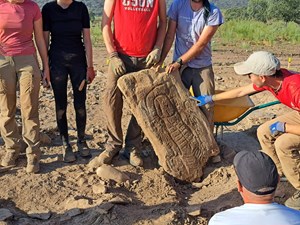
A new decorated stela has been found in context, in the 3000-year-old funerary complex of Las Capellanías, in Cañaveral de León (Huelva, south-west of Spain). It is thought that late prehistoric stelae in Iberia were created to commemorate important personages.
This new stela depicts a human figure with a headdress, a necklace, and two swords. The figure also has a detailed face, hands and feet, as well as male genitals. Las Capellanías is being excavated within a fieldwork project co-directed by the Department's Dr Marta Diaz-Guardamino.
There are three main reasons why this stela is such a valuable find. Firstly, this is the third decorated stela found at this site, and the second one found in context. This find is remarkable, as the contexts of use of late prehistoric stelae in Iberia are largely unknown, despite over 120 years of research. This is due to a variety of reasons, including the conditions of discovery (normally agricultural work) and the lack of archaeological fieldwork conducted at the find spots.
The find is also notable because it confirms, once more, what the second stela found at the site had suggested (in addition to some previously-known indirect evidence): that late prehistoric decorated stelae were primarily used as funerary monuments within mortuary sites.
This also indicates that stelae-making could have been an activity invested with special meaning, carried out as part of funerary rituals in Late Bronze Age and Early Iron Age Iberia. The fact that three stelae have been found at Las Capellanías funerary complex indicates that previous finds of other grouped stelae - e.g. those stelae found in Hernán Pérez in northern Cáceres, central-west Spain, now part of the collections of the National Archaeology Museum in Madrid - could have corresponded also to stelae that were originally set in funerary complexes.
Las Capellanías (like Hernán Pérez) is also located within one of the most important natural pathways linking two main river basins. During late prehistory, these pathways were key communication 'highways' between the middle Guadiana and the lower Guadalquivir basins. For Hernán Pérez, this 'highway' ran between the middle Tagus and the middle Duero, through the Gata mountain range.
Las Capellanías' location here is significant, especially when we consider where funerary sites and settlements are on these 'highways'. This shows how the role of decorated stelae as territorial markers relates to their role as funerary monuments.
This find is also unique because of what it tells us about previous gender interpretations of the people represented on stelae. It shows that prior interpretations actually relate more to our modern binary conceptions of gender, than to those of prehistoric societie.
This new stela from Cañaveral de León includes features like a necklace or a headdress. These are typically found on stelae classified as ‘headdress’ (or ‘diademated’) stelae, and usually interpreted as female. Traits typically found on the so-called ‘warrior’ stelae (such as swords) are normally interpreted as male. This gendering of standardised iconographies (possibly linked to specific social roles) was based on a very small percentage of cases displaying sexual bodily traits. Out of 31, four stelae were found with female sexual traits and headdress features. There were also four with male genitals and ‘warrior’ related paraphernalia, out of 147.
The stela 3 of Cañaveral de León changes all this. It combines traits of ‘headdress’ and ‘warrior’ types, showing that the social roles depicted by these standardized iconographies were more fluid than previously thought. Furthermore, as the new stela also includes male genitalia, it demonstrates that these social roles were not restricted to a specific gender, but could be associated with different genders.
Main Image :Students recording the area where the Cañaveral de León 3 stela was found.

ArtDependence Magazine is an international magazine covering all spheres of contemporary art, as well as modern and classical art.
ArtDependence features the latest art news, highlighting interviews with today’s most influential artists, galleries, curators, collectors, fair directors and individuals at the axis of the arts.
The magazine also covers series of articles and reviews on critical art events, new publications and other foremost happenings in the art world.
If you would like to submit events or editorial content to ArtDependence Magazine, please feel free to reach the magazine via the contact page.